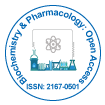
Biochemistry & Pharmacology: Open Access
Open Access
ISSN: 2167-0501

ISSN: 2167-0501
Editorial - (2012) Volume 1, Issue 6
This Editorial makes a brief description of the principal pharmacological agents that have demonstrated effect on the transport properties of animal aquaporins. The recent discoveries of intracellular inhibitors, such as bumetanide and furosemide are included. Finally, studies for comprehension of gating mechanisms in aquaporins are mentioned as perspectives for future research.
<Keywords: Aquaporins; Inhibitors; Bumatanide; Furosemide; Mercury chloride
All living organisms exchange matter and energy with the surrounding environment. In this sense, osmotic balance plays a crucial role for maintenance of cellular steady states. This feature of the cellular physiology is common for cells from all living Kingdoms, and extends to other levels in tissues and organs.
The mechanisms by which water passes through biological membranes have been a subject of intense research. In living cells, water can cross lipid bilayers by diffusion, can pass through water channels –known as aquaporins (AQPs)–, or be co transported along with solutes. Among these possible mechanisms, the AQPs exhibit the highest transport rates. These proteins are widespread in Nature [1] and much of their importance in physiological processes and diseases has been revealed since its discovery [2]. The history of the water channel hypothesis was supported by experimental evidences provided by physiologists. However, it took several decades to confirm the actual existence of water-channel proteins. Meanwhile, several studies supported interesting theories regarding the behavior of water inside channels, and the nature of the osmotic movement.
Nowadays, it is well known that different AQPs exhibit different transport rates –i.e. water permeability coefficients (Pf). In addition, some members of the AQP family don not transport just only water but also other substances as glycerol –these constitute the so called aquagliceroporins [3], or even gases as NO [4]. Of course, these differences in transport specificities emerged as a consequence of the different environmental conditions that determined the evolution process.
All the members of the AQP family are small, very hydrophobic, intrinsic membrane proteins, which are present in the membrane as tetramers. Nevertheless, the channel for water permeability does not reside in the center of the tetramer (as it does for ion channels). Instead, each monomer constitutes a channel [5]. The sequence alignment of the AQPs monomers shows several highly conserved motifs, among which two repeating Asn-Pro-Ala (NPA) are highlighted [6]. These are known as the signature sequence motifs of these proteins. The conformation of each monomer in the membrane shows six membrane-spanning α-helices and two long loops, one cytosolic (loop B) and the other extracellular (loop E). Both the N and C termini of the proteins are intracellular. One NPA motif is located in loop B and the other in loop E. These loops deepen into the membrane constituting a seventh transmembrane pseudo helix, opposing the two NPA motifs near the center of the channel. The AQPs also share another highly conserved sequence, the aromatic/arginine (ar/R) region, which exits at the extracellular side of the channel and constitutes the selectivity filter of the protein.
The study of water transport through biological membranes experienced a significant impact since the discovery of AQPs [2]. The pursuit for a further comprehension of their regulation caused a wide range of studies to be developed. Initially, the study of water transport through AQPs was centered on finding drugs that could modulate the activity of the channel. Mercury chloride was early on accepted as the extracellular inhibitor of AQPs [7]. In AQP1, the residue Cys 189 has been shown to be the site of mercurial binding and water transport inhibition, and its mechanism of action has been described at a molecular level by means of molecular dynamic (MD) simulations [8]. According to alignment comparison with AQP1, others AQPs have cysteine residues at identical locations in their amino acid sequences. However, it was demonstrated that not all AQPs are inhibited by HgCl2. The characteristic case is AQP6, whose water permeability is increased in presence of this mercurial agent [9]. Mercury chloride also reduced the water transport rate of the mammalian AQP4 but by acting from the intracellular side of the channel [10]. Other drugs, such as bumetanide and derivatives, were also described as intracellular inhibitors of rat AQP4 [11].
Other agents, such as tetraethylammonium and phloretin were proposed as blockers for AQPs [12]. However, these compounds showed low specificity and potency.
Up until now, intracellular aquaporin inhibitors were tested indirectly or by the intracellular injection of the drug. In the mentioned case of furosemide, bumetanide, and derivatives, these were tested as possible intracellular inhibitors of rat aquaporin 4 (rAQP4) by means of injection or by developing permeable drugs. This double-injection of both cRNA and drugs alters cellular membrane integrity, which may be inconvenient for water movement measurements, especially in the case of very fast volume changes [13]. The emptied-out oocyte technique (EOO) opened up several new possibilities: among others, the chance to have full control of the experimental solution on both sides of the oocyte membrane [14]. This made possible to test the inhibitory effect of new drugs acting directly on the intracellular side of membranes expressing aquaporins. Following the line of study on AQP function modulation, our group demonstrated that furosemide is an intracellular inhibitor of hAQP1 [15]. The possible amino acids involved in the site of action of furosemide in hAQP1 could be Gly72, His74, Tre156 and Ala168. Despite its advantages, the EOO technique does not intend to replace the easier-to-implement whole-oocyte method. Instead, it should be viewed as a complementary technique for specifically studying events that occur on the cytoplasmic side of an intact cellular membrane.
The need for pharmacological agents to dissect the roles of aquaporins in physiological and pathological processes is a clear call for further research in the field, but also aquaporin gating mechanisms suggest that conformational changes are important elements in their regulation. In this sense, the EOO technique is a very powerful tool to study possible gating mechanisms on AQPs.